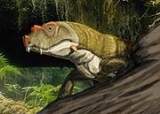
Tetraceratops
Encyclopedia
Tetraceratops insignis ("Four-horned face emblem") was a lizard
-like synapsid
. It lived during the Early Permian
period. According to a recent, controversial report, T. insignis is the first known therapsid. Other scientists, on the other hand, say that it is a more primitive species of synapsid, possibly an unusual, lizard-like pelycosaur
, as originally thought. Evidence in favor of the pro-therapsid camp shows that Tetraceratops' temporal fenestra resembles that of biarmosuchia
ns and other Permo-Triassic therapsids.
It is known from a single 90 millimeter long skull, discovered in Texas, during 1908.
 Contrary to its genus name, Tetraceratops actually has six horns, one pair being on the premaxilla
Contrary to its genus name, Tetraceratops actually has six horns, one pair being on the premaxilla
bones, one pair on the prefrontal bones, and one pair on the angular processes of the mandible
. When it was discovered and described in 1908, the skull was still embedded in a matrix, and only the premaxilla and prefrontal pairs were visible. In life, thus, it would have resembled a lizard with four horns on its snout, and a pair of large spines emanating from the corners of its jaw.
Lizard
Lizards are a widespread group of squamate reptiles, with nearly 3800 species, ranging across all continents except Antarctica as well as most oceanic island chains...
-like synapsid
Synapsid
Synapsids are a group of animals that includes mammals and everything more closely related to mammals than to other living amniotes. They are easily separated from other amniotes by having an opening low in the skull roof behind each eye, leaving a bony arch beneath each, accounting for their name...
. It lived during the Early Permian
Permian
The PermianThe term "Permian" was introduced into geology in 1841 by Sir Sir R. I. Murchison, president of the Geological Society of London, who identified typical strata in extensive Russian explorations undertaken with Edouard de Verneuil; Murchison asserted in 1841 that he named his "Permian...
period. According to a recent, controversial report, T. insignis is the first known therapsid. Other scientists, on the other hand, say that it is a more primitive species of synapsid, possibly an unusual, lizard-like pelycosaur
Pelycosaur
The pelycosaurs are an informal grouping composed of basal or primitive Late Paleozoic synapsid amniotes. Some species were quite large and could grow up to 3 meters or more, although most species were much smaller...
, as originally thought. Evidence in favor of the pro-therapsid camp shows that Tetraceratops
Biarmosuchia
Biarmosuchia, also known as Eotitanosuchia and Phthinosuchia, is an assemblage of primitive Permian therapsids that represent either a paraphyletic stem group or a very early off-shoot of the main therapsid tree....
ns and other Permo-Triassic therapsids.
It is known from a single 90 millimeter long skull, discovered in Texas, during 1908.
Appearance

Premaxilla
The incisive bone is the portion of the maxilla adjacent to the incisors. It is a pair of small cranial bones at the very tip of the jaws of many animals, usually bearing teeth, but not always. They are connected to the maxilla and the nasals....
bones, one pair on the prefrontal bones, and one pair on the angular processes of the mandible
Mandible
The mandible pronunciation or inferior maxillary bone forms the lower jaw and holds the lower teeth in place...
. When it was discovered and described in 1908, the skull was still embedded in a matrix, and only the premaxilla and prefrontal pairs were visible. In life, thus, it would have resembled a lizard with four horns on its snout, and a pair of large spines emanating from the corners of its jaw.
See also
- List of synapsids
- Evolution of mammalsEvolution of mammals__FORCETOC__The evolution of mammals within the synapsid lineage was a gradual process that took approximately 70 million years, beginning in the mid-Permian. By the mid-Triassic, there were many species that looked like mammals, and the first true mammals appeared in the early Jurassic...
- BiarmosuchiaBiarmosuchiaBiarmosuchia, also known as Eotitanosuchia and Phthinosuchia, is an assemblage of primitive Permian therapsids that represent either a paraphyletic stem group or a very early off-shoot of the main therapsid tree....

